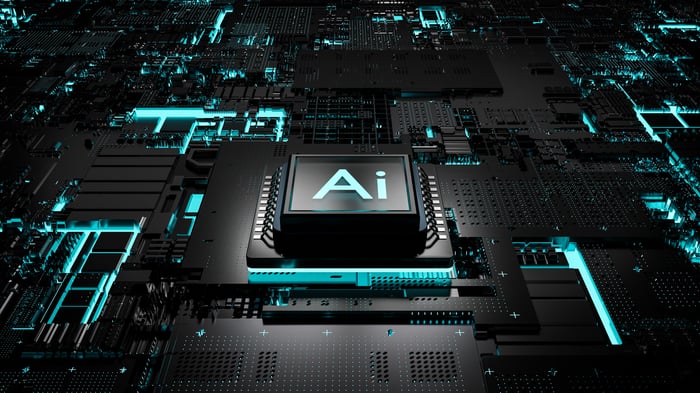The semiconductor sector received a lot of attention in 2023, mainly because Nvidia stock surged 237% on the back of demand for its data center chips for artificial intelligence (AI) workloads.
But Nvidia's success masked substantial weakness in other areas of the semiconductor industry. Economic headwinds like high inflation and rising interest rates forced consumers to spend less money in segments like personal computing and gaming, which sent demand for traditional chips plummeting.
Micron Technology (MU 2.92%) was a poster child for that weakness earlier this year, but its recent financial results for the fiscal 2024 first quarter (ended Nov. 30) suggest a comeback is underway. Here's why it's time to buy the stock.

Image source: Getty Images.
Artificial intelligence will spark a new growth phase for Micron
Micron is a leading producer of memory (DRAM) and storage (NAND) chips. That hardware isn't quite as exciting as the glamorous GPUs produced by Nvidia that have become the beating heart of the data center, but they are equally important, especially under the demand of AI workloads.
Micron's new high-bandwidth memory chip (HBM3E) has been designed specifically for generative AI applications, with 10% more output and 30% less power consumption than competing hardware. HBM3E was selected by Nvidia to power its new flagship H200 data center chip, which is expected to extend the company's advantage over its competitors in the GPU space.
Micron is now gearing up for a monumental shift toward AI at the edge. While most of the AI action is happening in the data center right now, it's about to move to every new computer, device, and car in the world. Micron says AI-enabled industrial computers, for example, require three to five times more memory than standard computers. That calls for more advanced chips that sell at a higher price, and that's great news for Micron.
Leading CPU and GPU maker Advanced Micro Devices is already bringing AI chips to over 50 notebook computer designs in partnership with tech giants like Microsoft. Each of those devices will require increased DRAM and NAND capacity compared to traditional models, which spells profits for suppliers like Micron.
Micron's financial recovery is underway
Micron's consumer segments struggled lately due to slowing sales of computers, devices, and gaming products. That led to an oversupply of chips and a huge inventory glut, which sent prices plunging. The company's revenue for fiscal 2023 (ended Aug. 31) sank by a whopping 50% year over year.
While those segments remain soft, they are improving, and Micron expects them to return to growth in calendar year 2024.
But the first quarter of fiscal 2024 was all about the data center. Micron's compute and networking segment generated $1.7 billion in revenue, and while that figure was flat year over year, it was up 45% compared to just three months ago. It was led by an increase in AI-related shipments, as well as normalized inventory conditions, which could drive prices higher in the coming quarters.
With relatively modest results in Micron's two other segments, compute and networking helped drive the company's total revenue to $4.7 billion, a 16% year-over-year jump. It was a welcome beginning to the new fiscal year following the dismal fiscal 2023.
Why Micron stock is a buy now
Micron still has some work to do to bring its bottom line back to profitability. The company lost $1.2 billion in Q1, which translated into negative earnings per share of $1.12. It marked a continuation of the company's trend of losses from fiscal 2023.
But better times are coming, according to management. The high end of Micron's guidance for the upcoming fiscal 2024 second quarter points to a possible $0.07 in earnings per share (profit). The company also expects to bring in $5.3 billion in revenue, which would mark an accelerated growth rate of almost 30% year over year.
Micron stock trades at a price-to-sales (P/S) ratio of 6.1, which is the most expensive level in at least a decade. But there are two reasons that shouldn't deter investors from buying shares:
- AI is driving valuations higher across the semiconductor industry. Advanced Micro Devices trades at a P/S ratio of 10.4, and Nvidia has a P/S ratio of 27.4. Both are also near their highs of the last decade.
- The P/S ratio is calculated based on trailing revenue, and we know Micron's sales collapsed in fiscal 2023. Looking ahead, Wall Street expects the company's revenue to increase 30% to $20.3 billion in fiscal 2024, which would reduce its P/S ratio to 4.7 on a forward basis.
Plus, analysts think Micron's revenue growth could accelerate again to 41% in fiscal 2025. Micron believes it's at the start of a multiyear growth phase driven by generative AI, and now could be investors' chance to buy the stock ahead of a continued upswing in its business.





